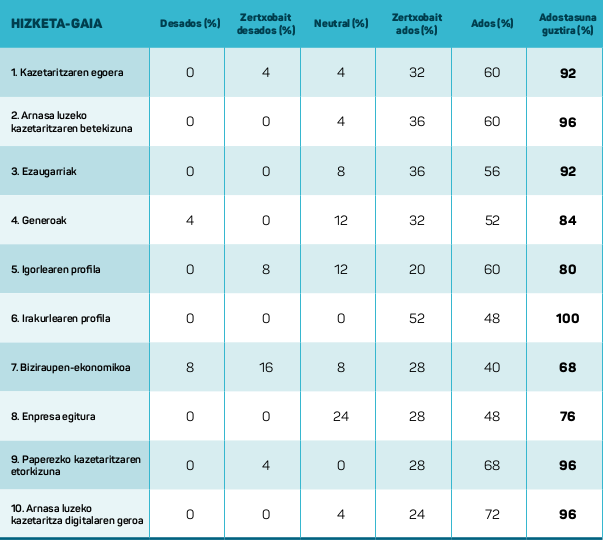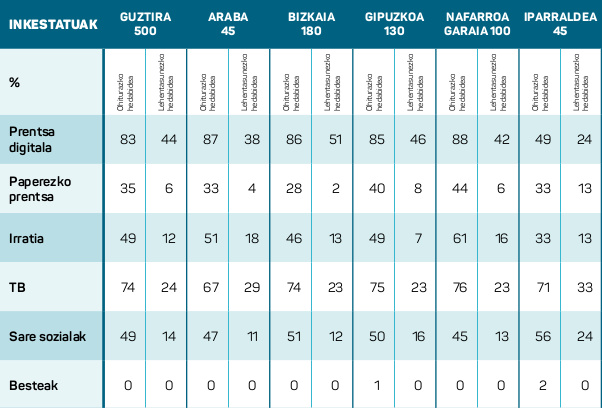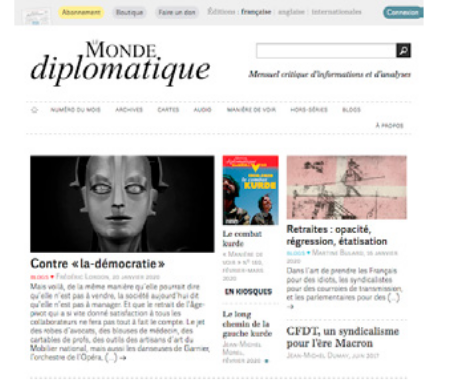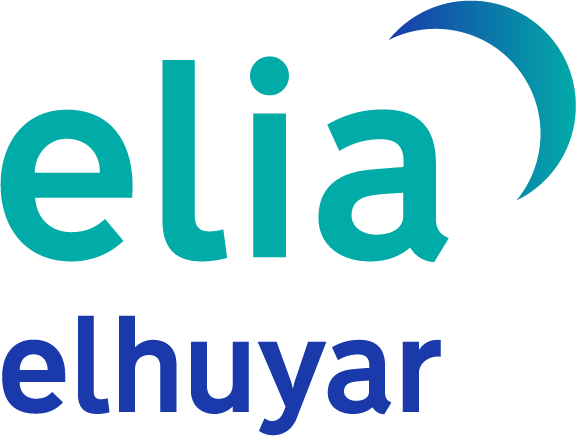Society and journalism are similar. The emergence of new social phenomena in recent years has surprised several experts. In the communication channel, the waters have been crumbling for a long time. Variability, speed and diversity are dominant both in society and in communication. Absolute insecurity. In this article we will talk about the future of news. Now that immediate consumption of news is dominating, we want to know what the future of long-inspired journalism is. The exploration has been carried out at three levels, analyzing current trends and strategies in the journalism world, collecting the opinions of 25 international experts and collecting the opinions of 500 readers from all over the Basque Country. The results have been as interesting as they were surprising in some cases.
Trends and strategies in the global world and in ours
WAN-IFRA is an international organization that brings together news editors and journalists from the 50 most economically developed states worldwide. Every year, around November, it publishes a global press study. Besides making the diagnosis, it tries to establish prognoses. The word ‘enigma’ is quite repeated in the report published in November 2019. The study highlights some significant data such as the fact that newspaper redactions continue to decrease, revenues continue to fall (3% compared to the previous year), but the readiness of readers to pay quality content is increasingly evident. Vincent Peyrègne, Managing Director of WAN-IFRA, explained it as follows: “In the era of questionable content, consumers are increasingly looking for reliable and quality content” (2019).
News that is considered fake live rather than debatable has proliferated everywhere in the last decade. Fake news has spread to many areas and states and the extension will not go any further. What is more, fake news is becoming more and more sophisticated and, from now on, it will be difficult for us to distinguish between what is true and what is false. It is a huge concern worldwide, because it is demonstrated (Lazer et al., 2018) that news of this kind be disseminated much faster and more deeply than the real news, until the political debate is constrained. Proof of this are the US election campaign in 2016, the referendum on Brexit in 2016, and the general elections in Brazil, among others. Not all points of view agree on how to address this phenomenon. While some believe that it is urgent to legally punish the responsibilities of editors and individuals who disseminate this type of news, others think that this is very difficult today (Dornan, 2017). Christopher Dornan in 2017 in the contribution to UNESCO of Canadian Carleton University announced: “Today it is not possible to discern the falsehood of the information ecosystem, and if a society were to succeed in controlling what could be said publicly, that society would not be free.” However, experts agree that the need to become aware of the media literacy of the population and the implementation of digital portals for news verification are fundamental measures.
Journalist Alan Rusbridger received the Pulitzer Prize in 2014 for publishing a report on Edward Snowden"s leaks with the newspaper The Washington Post, in which he stood out as Guardian"s main editor. It also carried out the digital transformation of the newspaper. The Guardian is a global benchmark of quality. Every month a hundred million people visit their website. Rusbridger is currently working at the Reuters Institute to study the evolution of journalism. For him (Rusbridger, 2018), speaking of the future of journalism “we all agree that nobody knows anything, but we also know that we do not want a world without newspapers”. The newspaper Ara, in its 2019 interview, acknowledged:
“I think the public is also not very clear about what journalism is, one of the great challenges we have as a journalist is to explain to people why some ways of doing journalism are better than others and why you have to believe these media and not those others. I believe that journalism is not aware of what it will still have to do to regain the trust of the receivers” (Vera, 2019).
In his opinion, the key words are confidence and quality.
Ara journalist Esther Vera asked Rusbridger in this interview what is most important to an informant, honesty or truth. The answer is:
“The truth word is very complicated. Sometimes historians need more than 200 years to reach a consensus on a concrete fact. Journalists often don"t have more than 20 minutes to know the truth, and we may not find a single version of the truth. Should we therefore be true or honest? I think what we have to do is look for the best version of the truth. But I am nervous about the term truth, because I do not believe that the public really believes that we have absolute truth” (Vera, 2019).
In a post-truth or post-post life, Rusbridger is clear that in the face of contempt and contempt given to the media authorities such as Donald Trump or Boris Johnson, asking how to react to the profession: “It makes no sense to declare war on Donald Trumpi or Boris Johnson. The only way to trust people in us is to be old school, that is, to tell things that are real and that are data-driven, nothing else."
To conclude the dialogue, Rusbridger made an interesting reflection on the journalism of paying quality content:
“I think collecting information is valuable and it is valid to be free. Neither can exclude the other. But the danger is to create an informed elite and the rest only consume nonsense. Thus, only 2% will receive good information and the remaining 98% will be part of a society that must be satisfied with the few. Should all contents be offered free of charge? How far should we extend paid journalism? What are the pros and cons of one strategy or another?” (Vera, 2019).
These are the concerns of the expert and perhaps the axes of a next article.
In the field of Basque journalism, we are immediately aware that all these concerns we have about the future of journalism are borne by the hundreds of small, medium and large media that are published in Basque. However, The Guardian et al. they have no other barriers than the Basque media, such as the day-to-day problems created by the need to work in a minority and non-standard language. The Basque media operates in a community without a state, regardless of the guarantees offered by the state and the executive laws. The Basque media focuses on the community. So every day they try to train, feed, compete and empower that community. This is one of their most important strategies: the future of the community. Audiovisual, paper and/or digital media that only work in Basque are well aware of this. Let us now look at the latest reflections of the national journals and journals of reference that are disseminated throughout the Basque Country on their actions and their future.
Journalist Berria, for example, in his strategic plan for the period 2019-2021, has made it very clear what his strategic bets are. The plan has been the result of a long participatory process in which most newspaper workers have been able to share their own thoughts. The future has an impact on the strategic lines of generating content that encourages engagement, identifying and developing jump themes/niches, focusing digital production and continuing to focus the community.
The strategic plan makes it very clear that Berria’s mission is to provide both immediate and long-term information: “In this sense, the priority of the next three years will be to take a step in the referentiality through the contents […] seeking to create content that generate commitment, making a special effort in certain themes and niches, and taking a step further in the network” (BERRIA, 2019).
Argia journalists have carried out a similar process of reflection. Being a weekly offers more possibilities for practicing long-inspired journalism. Gorka Bereziartua, a local journalist, offers in his latest book (Ez gara neutralak, 2019) some clues about the Argia approach:
“The unification, the need to inform immediately and at all times, the information hotbeds that move continuously, have caused the office to slide to the tachograph, to the fast press of the key, before asking. It is increasingly difficult to look at a given thing in a different way. And at the same time, it is so necessary to have its own agenda […] that we may have to review the concepts. Freeing ourselves from our servitude with the present and taking care of reality” (Bereziartua, 2019).
Later on, Bereziartua recalls the following reflection of Pello Zubiria, one of the souls of the Argia:
“Once I read someone: I am not interested in the present, I am interested in reality […] We have reality Txit Urre and at the same time Extremely Far. Reality is hidden from the citizen by the fact that today communication is almost a monocult, that is, entertainment or entertainment, which is a spectacle of past times” (Bereziartua, 2019).
In view of current trends and strategies both inside and outside the home, let us give voice to academics and professionals who have now analyzed narrative journalism or long-inspired journalism.
The situation of long-inspired digital journalism from the point of view of experts
To explore an overview of this relatively recent journalism trend, the HGH research group has used the Delphi methodology to gather the opinion of international experts. This technique, which serves, among other things, to analyze the future of under-researched topics, is one of the lines of inspired digital journalism. Most studies published to date on this subject are based on case studies and theoretical approaches. In these research flows, however, it is not yet possible to appreciate a consensus on the subject, either in its definition or in its function.
To fill this gap, we have contacted experts in the field from different countries, professionals who collaborate and/or practice with this type of journalism, as well as academics and researchers who are competent in this research topic. The aim has been to gather their views on our research object and to foresee its future trends. Achieve consensus among the participants and answer the following research questions of the project as a final objective.
- IG What is the situation of long-inspired journalism on the net?
- IG What are its main characteristics today?
- IG What future is foreseeable?
To answer these three questions, we developed an online questionnaire with ten qualitative questions. The answers to the questions were open and the experts had a small box to write the answer. In the second round, in addition to the ten questions, we added the results of the first round and a Likert scale to evaluate and quantify the answers (consensus and discrepancies) of the experts. Between the two shifts, a summary of the results was sent to all the experts. The questionnaires and the summary table were given in three languages (Basque, Spanish and English). The submission and data collection of Delphi questionnaires began in May 2008 and ended in April 2019. The considerations of all participants were collected anonymously and each expert was assigned a number code. The profile and origin of the participants is as follows:
- Sample: 25 people.
- Country: Australia (N=1), Europe (N=18), North America (N=4) and South America (N=2).
- Age: 30-40 (35.71%), 40-50 (39.28%), over 50 (25%).
- Gender: Female (48%), Male (52%), Non-binary (0%).
- Work area: Academic (53.57%), Professional (39.29%), Both (7.14%), Others (0%).
- Work experience and educational level:
- Number of years linked to the academic/professional world:5-10 (28.57%), 10-15 (25%), more than 15 (46.42%).
- Work experience abroad: Yes (78.57%), No (21.43%).
- Work centre: At home (25%), Moves to work (25%), The two (50%).
It should be noted that, after the second round, in eight of the ten speech themes, the degree of compliance of the experts was greater than 80% (see Table 1). Considering that the level of conformity reached among the experts was high, a third round of the questionnaire was discarded.

The results are summarized below, classified by thematic areas, as well as the nuances and reflections of the experts in each of them.
Journalistic situation
Experts who have responded to the Delphi questionnaire point out that the current situation of journalism is different in each of the countries in which it is going, and that it is therefore difficult to imagine a single situation. Although the international communicative ecosystem is diverse, in general, they point out that quality and credibility have been reduced to troubling levels. However, they recommend differentiating between quality and credibility of information, as they are not always related. According to experts, the reason for being optimistic has a fundamental element: renewing the relationship with the audience. In other words, to analyse and better understand the audience and, curiously, the metric systems (positioning, impact, virality, possible, etc.) also call for minor importance. Instead, transparency, verification and interaction are the precautionary stimuli mentioned by experts. Disagreement experts underline the polarization of the current situation of journalism. Some people think that the journalism business model is in crisis, and that"s the biggest problem of the trade. Others, on the contrary, expect in subscription models and in the wave of slow movement driven by young people.
The role of long-inspired journalism
The function of this type of journalism would be to provide quality and informative rigor, and to be able to educate and achieve the involvement of the audiences. However, based on data from cartelera and hearings, experts stress that the long-inspiration journalism market is limited, as its weight is still low compared to the traditional sector. Even if it"s on the rise, experts say it has never replaced fast consumer journalism, which is not the goal of this trend either. They both have to live with each other, but they clarify that long-inspired journalism is more necessary than ever to combat misinformation. They recall that journalism (without surnames) should perform the same functions, but it seems that today the addition of this name or label has become essential because current journalistic practices demand it.
Characteristics
Among the characteristics of this type of journal are: the time and distance needed to conduct the studies; depth; context and information independence; value stories; participating audience; creative ability and use of new technologies. The participants of the questionnaire also affirm that the key to success lies in some cases in the specialization and in others in the work with coherence, that is, in the marking of a proper editorial line and in the audiences centered on a given sector. In this sense, experts agree on the importance of experimenting with new narrative formulas and optimizing resources to make information more visible.
Genera
As for the genre of news, in general, all formats that foster complexity and analysis would form the natural framework of long-inspired journalism. However, most experts agree that the most appropriate genres to develop the potential of this journal are those of interpretation: in-depth reporting and interview, chronicle and opinion column. There are also hybrid genera that stand out. Others, however, consider that gender “should not be the reference of long-inspiration journalism, since it does not coincide with the objectivity and values of this type of periodical. Once again, experts consider that audiovisual media have a great force to create and compose different narrative styles, but stress that they should not be used to replace textual writing. Conversely, new technologies should be used to add information value.
Issuer profile
The profile of the long-inspiration journalistic issuer is a hybrid profile specialized in a field, with a solid educational level and its own capacity for initiative and creativity. In any case, the issuer must have extensive experience in journalistic writing and know and implement the ethical principles of the trade: accuracy, objectivity, quality, transparency, including information and truthfulness. Some experts say that the broadcaster of long-inspired journalism should have competition with different professionals (photographers, video artists, graphic designers, developers, etc.) To work, others think it"s enough to be a good journalist and a writer.
Reader profile
Consumers with long air are often more interested in press quality than fast consumption. In fact, he would be a more sensitive reader, with curiosity and active cultural awareness, with enough time to analyze the details and depth of the stories. Experts agree that the higher the readers" intellectual level, the greater the interest in this type of journalism, since it is not a mainstream journalism, and this type of readers is not found at the journalistic level of less than 5,000 words. In this sense, they consider it essential to work on the interaction with readers, gather their opinion and evaluate. Long-inspired journalism enshrines and cares for its own reading community (essential for subsistence), so it is important that the produced projects be open to this audience and allow their participation and involvement.
Bizan-economic
Some authors consider that any model can be appropriate for this type of media, provided that it does not harm the work of professionals or the independence of the media. In the opinion of the participants, the economic analysis is based on the independence of the medium, from which its attractiveness will derive. Complementary funding includes subscription, crowdfunding, sponsorship and donation systems, as the source of revenue from traditional advertising does not function as in the past in these media. In general, they do not see public funding as the main source of income, but as a complementary alternative. They also point out that red lines should be established when selecting advertisers to, among other things, allow irresponsible institutions (which base production and economic benefit on savage capitalism).
The most distrust issue among experts has been the regulation of the government of the communication system. Some of them are opposed to the concept of regulation. Others advocate the institutional protection and regulation of long-inspired journalism, provided that the independence of the media is not impaired.
Business structure
According to experts, there is no single general formula of the business structure to better adapt to the objectives of this type of journalism. However, the most cited legal funds have been the business models that combine cooperatives and mixed structures. They say they are the main ways to ensure long-inspired and coherent journalism.
The future of paper journalism
Despite the difficulty of predicting the future, experts believe that new publications will be created for selected readers and probably the main general information journals of each country will be maintained. According to the experts, both situations would be complementary. Technological change has meant that some experts have not been very optimistic about the future. Beyond the simultaneous coexistence of physical and digital media, some experts prefer the visibility of independent digital media directed to concrete audiences. However, they do not want to abandon the need to mass media to reach a wider audience.
The future of long-inspired digital journalism
Participants are generally optimistic. According to them, there will always be a market share for such newspapers, as the gap between fast and slow consumption will increase. A majority considers that the current trend is the development of new digital content and the increase of audience and media visibility. However, by geographic scope, participants indicate that this process will occur at different levels. All experts want long-inspiration journalists to be able to adapt to digital change. The main question is whether or not this minority journalism will achieve a viable business model.
Basque audience in search of air
What are the consumption habits and trends of the Basque population in relation to the media? As in other areas, it is difficult to make a single photograph of the entire Basque Country. On the one hand, because there are no measuring sources for the audience at national level and, on the other, because most of the media that are published and produced in the Basque Country are from the South — and there are no measurements that bring together the most important media in Araba, Bizkaia, Gipuzkoa and Navarra.
Although it does not collect data from Berria or Gara, the OJD is the most widely used source for measuring newspaper sales in Spain. The agency clearly shows the decline in sales of interannual written press. Although there are difficulties in making a joint measurement in the Basque Country, the instruments at our disposal also coincide in highlighting this decline. For example, data from the EGM show the same trend. According to this research body, sales have also decreased considerably in the last decade in the Spanish State: From 16,056,000 in 2009 to 8,969,000 in 2019 (Cano, 2019).
The paper press is hardest hit by the new possibilities of receiving information that the Internet has brought. At the same level, radio and television stations have also suffered the effects of new media and social networks. Indeed, according to EGM and the measurement companies Kantar Media1, television is losing its audience year after year. And although global radio consumption is increasing, the most generalist radio is coming down.
The research group Media, Society and Education (ECG) of the UPV/EHU also presents a survey conducted in July 2019 throughout the Basque Country 2. Currently, the most consulted information support in the seven countries is the digital press (83% of respondents). Television followed him closely (74%). Although the paper newspaper shows strength (35%), it follows the radio (49%). In addition, social networks already have the same percentage as the radio generated at the beginning of the last century. According to the media preferred by the Basque population when it comes to reporting, there are no great differences between countries. The most significant difference between data from the South and North is the lower intensity of the digital press in Lapurdi, Nafarroa Beherea and Zuberoa (see Table 2).

The causes of the decline in regular media consumption have been related to the decrease in the electoral status. Editorial lines (ideology) have been accused of looking too much at political power or the needs of companies that can afford predictions. Or, and this seems to have a contradiction, the search for immediate impact has often led the media to light content that multiplies sales or clicks. The list of bad journalistic practices would not be complete without making any reference to the contents published without contrasting them or verifying them by the speed of the Internet.
There are, therefore, a number of reasons that have led Basque citizens to move away from using traditional media. To what extent are they willing to give the opportunity for journalistic experiences focused on quality? According to the work carried out by the CIES for this study, 33% of the Basque population thinks that journalism itself should become a long-inspired journalism. But not of any kind, but of digital support. In fact, a large majority of respondents (68%) believe that the audiovisual and multimedia resources supported by the network improve the understanding of users" news. This idea therefore clashes with the idea that it has been used to allocate depth to the paper newspaper. In contrast, only 12% believe that images have less objectivity or are more sensationalist.
If 33% are in favour of long-term digital journalism, 24% are willing to pay the media that are promoting this type of journalism the extraordinary quality that is attributed to them. There is a factor related to depth and that considerably increases this figure, that of training, since willingness to pay increases with studies. Thus, among those with graduate studies, 38% claim to pay for receiving news in a narrative form. Analyzing the data in detail, we found that 15% of the population acknowledges having paid or paid for a digital subscription. The percentage of media on paper is almost the same (14%). In the case of long-inspired digital journalism, the percentage of subscribers in the Basque Country is 10%.

Anyway, what is the number of Basque citizens who consume media that can be called long-inspired journalism?
According to the results offered by the CIES for this study, almost one in four Basques has consumed, at least once, some medium of communication with prolonged breathing. Specifically, 23%. The most widely read media is Spanish Jot Down (36%).

La Marea (Spanish), Charlie Hebdo (French), Yorokubu (Spanish) and Le Monde Diplomatique (French) follow.

The predominance of state languages in the division between Iparralde and Hego Euskal Herria is evident.
Among the media held in the Basque Country are Pikara Magazine, Argia, Diario Vasco and Explora Navarre, respectively. The quantities obtained are not significant and only one of the quantities obtained in Euskera appears: Light. It should be noted that the citizen who participated in the survey was asked which of the 23 media outlets he had read and that there were no Basque media on that list. Those who expressed Pikara, Argia, Diario Vasco and Explora Navarra were told if they knew anything else. Is it a question of definition or perception?
According to 12% of participants, there is a classifiable "classical media" within long-inspired journalism. Almost one in four Basques identifies what is a long-inspired journalism and (in their opinion) refers to a media dedicated to it. But it"s much lower than the number of people who often approach the media who do long-inspired journalism. Only 7% have such a means available to them all or almost every day.
The most significant differences correspond to support. In Hego Euskal Herria the internet is the most used source for consulting information. In the north, on the contrary, the difference between paper and net is not so pronounced. Likewise, those who do it online do it mainly with the mobile phone (67%).
The higher level of training associated with the far-reaching media mentioned above coincides with the thematic informative framework sought by the readers. The most frequently consulted articles are cultural (69%). It is followed by social issues (64%), political issues (59%), science and technology content (48%), international (44%) and economic (35%). It is noteworthy that, in this case, the sports field that grants large audiences to the mainstream media, but gender does (53%). Therefore, the Basque audience of long-inspired journalism has among its characteristics critical opinion and analytical capacity.
These topics have always found the most appropriate journalistic genre, and the survey reveals that, also in this case, there is a type of narrative ideal to tell stories in depth: the genre preferred by the readers of Basque inspired journalism is the report, the analysis the second and the chronicle the third.
Therefore, in summary, it could be stated that among the Basque population there is a (albeit modest) presence of long-inspired journalism, as well as a qualitatively valued good.
Loose liver
The reflection of the Sardines philosopher, politician and journalist Antonio Gramsci, Meneses, 2015, is often used to explain the circumstances surrounding transition situations: "The old world is dying. The creation of the news will be long. And in that light the monsters rise."
In this sense, the cracks of journalism arising from fast philosophy are increasingly evident. On the other hand, slow journalism or long-inspired journalism is on its way; slowly and slowly, but it goes. And in the Biscayan realm, the ghost of fakes news or fake news is spreading and becoming more and more sophisticated.
Rusbridger will be right, to regain public confidence and to take care of the quality of content will be the key to the future.
Bibliography
Bereziartua, G. (2019): We are not neutral, More intense communication, S.L., Hurt yourself.
NEW (2019): Berria Strategic Plan 2019-2021 (working document), EKT, Andoain.
Cano, F. (2019): The agony of paper: newspapers lose seven million readers since the beginning of the crisis, <https://www.elalised <https://www.elespanol.com/economia/medios/20190627/agonia-diarios-pierden-millones-lectores-comienzo-crisis/409210169_0.html> <https://www.elespadin.com/economia/medios/20190627/agonia-sideconum-lab-peden-efecto-crisis/409210169_0.html> .com/economia/media/20190627/agonia-daily-effect-memory-start-crisis/409210169_0.html> <https://www.elespadin.com/economia/media/20190627/agumlab-conum9crisis.
Dornan, C. (2017): ‘The ear, present and future of fake news’, Series of reflection papers, Canadian Commission for <https://www.research gate.net/publication/335881115_Dezinformatsiya <https://www.researchgate.net/publication/335881115_Dezinformatsiya_The_past_present_and_future_of_’fake_news’_A_Reflection_Paper_for_the_Canadian_Commission_for_UNESCO> UNESCO, <https://www.research gate.net/publication/335881115_Dezinformatsiya <https://www.researchgate.net/publication/335881115_Dezinformatsiya_The_past_and_future_of_’
Lazer, D.et al. (2018): "The science of fake news. Addressing fake news requires a multidisciplinary effort”, Science 09 (359), Issue 6380, p. 1094-1096, exp. 10.1126/web-aao 2998. <https://disruptor.es/wp-content/uploads/2018/03/US-2018-SCI-MAG-FAKE-NEWS-090318-1.pdf> <https://disruptor.es/wp-content/uploads/2018/03/US-2018-SCI-MAG-FAKE-NEWS -090318-1.pdf> <https://disruptor.co.uk/wp-content/uploads/2018/03/US-2018-SCI-MAG-FAKE-NEWS-090318-1.pdf> <https://disruptor.co.uk/wp-content/uploads/2018/03/US-2018-SCI-MAG-NEWS -090318-1.pdf
Meneses, J. P. (2015): A return to the third world: The wild route of globalisation, Debate Barcelona.
Peyrègne, V. (2019): World Press Trends 2019, <https://www.wan-ifra.org/reports/2019/10/28/world-press-trends-2019> <https://www.wan-ifra.org/reports/2019/10/28/world----trends-2019> <https://www.wan-ifra.org/reports/2019/10/28/world-press-trend-2019> <https://www.wan-ifra.org/reports/2019/10/28/world-trend-2019>.
Rusbridger, A. (2018): Breaking News: The Remaking of Journalism and Why It Matters Now, Farrar: Straus and Giroux, NewYork.
Vera, E. (2019): Alan Rusbridger: ‘The millor schedule model is confiança i la <https://www.ara.cat/suplements/diumenge/Alan-Rusbridger-negocIes <https://www.ara.cat/suplements/diumenge/Alan-Rusbridger-negocIes-confianca-qualitat_0_2349964991.html> qualt’, <https://www.ara.cat/supents/diumenge/Alan-Rusbridger-negocIes <https://www.ara.cat/supplements/diumenge/Alanalt-Rusbridger-negocFk-confianca-qualitat_0_2349964991.991.991.
1.- The main audience reference of the television market in the Spanish State.
2.- The work was carried out by the company CIES. The questionnaire, focused on long-inspiration journalism, was distributed to 500 inhabitants of the seven Basque countries, taking into account the weight of the population in each of them. The number of people surveyed was distributed as follows: 180 in Bizkaia, 130 in Gipuzkoa, 100 in Nafarroa Garaia, 45 in Araba and as many in Iparralde (pooling data from Lapurdi, Nafarroa Beherea and Zuberoa). Regarding gender, 283 women were surveyed, 213 men and 6 non-binary genera. Regarding age, 136 respondents participated from 18 to 34 years, 222 from 35 to 49 and 142 from 50 to 65 years. The level of education was as follows: Elementary or lower education: 30 participants; Bachiller Superior, F.P. 1-2: 165; University studies: 220; Postgraduate University: 85 85. Regarding the size of the municipalities, 83 resided in populations under 10,000 inhabitants, 175 in populations between 10,000 and 50,000 and 242 in populations over 50,000. Finally, 442 respondents were active and 58 inactive.
3.- It is based in Paris and its editions in French and Spanish, being in this case the most sold version in French, since in the Northern Basque Country half of those who have ever read a long inspired journalism have had this medium in their hands.


